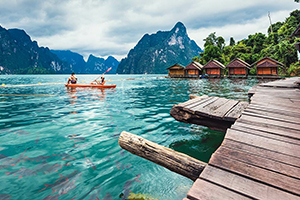i) Rajjaprabha Dam
Damis is located in Tambon Khao Phang, Amphoe Ban Ta Khun, Surat Thani. The dam and hydropower plant were inaugurated on September 30, 1987, by King Rama IX, who bestowed the name “Rajjaprabha,” which means “Light of the Kingdom,” in conjunction with the purpose of generating electricity.
With breathtaking scenery inside the Reservoir, also known as Chiao Lan Lake, consisting of a range of undulating limestone mountains rising from the emerald sea and indigo blue sky, with mist occasionally drifting along the mountaintops, the Dam can offer a variety of activities within the lake, such as sightseeing by boat, staying overnight on rafts, kayaking, spotting animals, and so on. This dam has become a once-in-a-lifetime destination for tourists, as well as the number one attraction on mainland Surat Thani province.
ii) Khao Sok National Park
is one of Thailand’s tropical rainforests with the highest density. The park is home to a variety of ecosystems and wildlife species, including rare and almost extinct birds like the Hooded Pitta and Malayan Banded Pitta as well as protected wild animals like the marbled cat, Malayan tapir, Fea’s muntjac, and serow. Additionally, it provides a habitat for endangered species of plants including the White Elephant Palm (Maxburretia furtadoana) and the parasitic Rafflesiakerrii, which has huge flowers with a diameter of 70–80 cm.
The Park is a destination for trekkers from all over the world as well as a tourism hub between the Daman Sea and the Gulf of Thailand. Many of them develop a love affair with the forest and keep going back. Such as kayaking, riding elephants, and canal tubing at Khlong Sok. One of the intriguing features of this location is a tree house designed for lodging that can be seen everywhere. They are all situated in the middle of a jungle. Other thrilling pursuits besides trekking exist.
iii) Khao Na NiLuang Dhamma Park
PhraAchanPhrai, a monk, established Khao Na Nailuang Dhamma Park in Tambon Thon Yuan, AmphoePhanom, Surat Thani. He worked together with the villagers to erect the stupa on a limestone plateau surrounded by beautiful vegetation. Early in the morning, a sea of mist will surround the place, giving the impression that a stupa is floating in the sky. The goal is to have seven stupas overall, each with a unique name and architectural style, and local residents who have free time will volunteer to assist build them.
iv) Khlong Nam Sai Ban Nam Rat, Amphoe Khiri Rat Nikhom
Since the water in the Canal is so clear that people can see the ground and fish, it was given the physical feature “Khlong Nam Sai.” The villagers in Amphoe Khiri Rat Nikhom depend on this canal as a natural, clean watershed for their daily needs.
v) Ko Raet
About 500 meters inland from the coast lies “The Ban Ko Raet Community,” which is situated on a tiny island in Mu 3, Tambon Don Sak, Amphoe Don Sak, Surat Thani. The neighborhood is a village of Thai-Hainanese fisherman who have lived here for approximately 200 years. It provides dolphin watching and island hopping sightseeing tours. There are currently seven homestays accessible for those who want to spend the night and learn about local culture. With the use of the walkways, visitors may stroll around the island and view a variety of islands, including Ko Samui, Ko Nok Phao, Ko Phaluai, Ko Lak, and Chedi Wat Khao SuwanPradit (Wat Pholuang Choi). Observing the sun, moon, and other celestial bodies as they rise and set is also breathtaking.
vi) Wat PhraPhutthabat Si Surat
The Buddha’s Footprint was discovered at Wat Khao To, which was afterwards renamed Wat PhraPhutthabat Si Surat, which is located at Mu 7, TambonTha U-thae, AmphoeKanchanadit, Surat Thani. It was the second Buddha footprint found in Thailand that has the same pattern as the one discovered in Saraburi province, and it was recognized as such by the Fine Arts Department on August 17, 1976. A Mondop has been magnificently placed over it today, and there are 347 concrete staircases leading up to it for worship.
The Buddha’s Footprint is 145 cm long, 80 cm wide, and has a depth of 47 cm.
vii) Phrathat Si Surat
Phrathat Si Surat, the first sacred site in the district, was constructed in 1957 on top of KhaoThaPhet, six kilometers south of the city center. It has a tall shape like a large candle or the Pillar of Ashoka and is embellished with stucco decorations. This stupa is regarded as the best example of Srivijaya architecture.
King Rama IX and Queen Sirikit visited Surat Thani on March 27, 1959, and while there, they paid respects to the stupa and planted Phayom (Shorearoxburghii) trees as a sign of good fortune. Later in 1984, HRH Princess Sirindhorn paid a visit and oversaw the installation of the Buddha’s relics as well as the planting of Khiam, or Cotylelobium lanceolatum, the Surat Thani provincial tree. Thus, for the locals, Khao ThaPhet is a sacred and historic location.
viii) Sinmana Farm
The famous oyster farm of Surat Thani, which is situated in Ao Ban Don, Amphoe Kanchanadit, has become so well-known that the slogan “Creamy white, big, and clean” was developed for the city’s oysters. Minerals and nutrients are in great abundance in Ao Ban Don. Oysters and other shellfish can live in the sea water.
To care for them, the oyster growers will erect a Khanam or shelter at the farm. This started as a modest shelter and evolved into a tourism enterprise and educational facility for oyster growing. On a recently constructed shelter in the midst of the sea, which has room for 100 people, tourists may view and learn about raising various shells. This can accommodate 100 guests, who will be served fresh oysters and other seafood while taking in the scenery and drinking coffee before either departing the farm or staying there overnight.
ix) LuangphuThuatWat Don Sak
The statue of Luangphu Thuat was built at Wat Don Sak, Amphoe Don Sak, Surat Thani, and has dimensions of 29.90 meters in width, 32.9 meters in height, and 10 meters in height at the base. The statue’s inside is separated into numerous compartments for holding the temple’s rituals. Tourists are encouraged to pay respects before exploring Surat Thani’s different Islands, according to the construction. It is now the biggest statue of LuangphuThuat ever constructed.


0 Comment